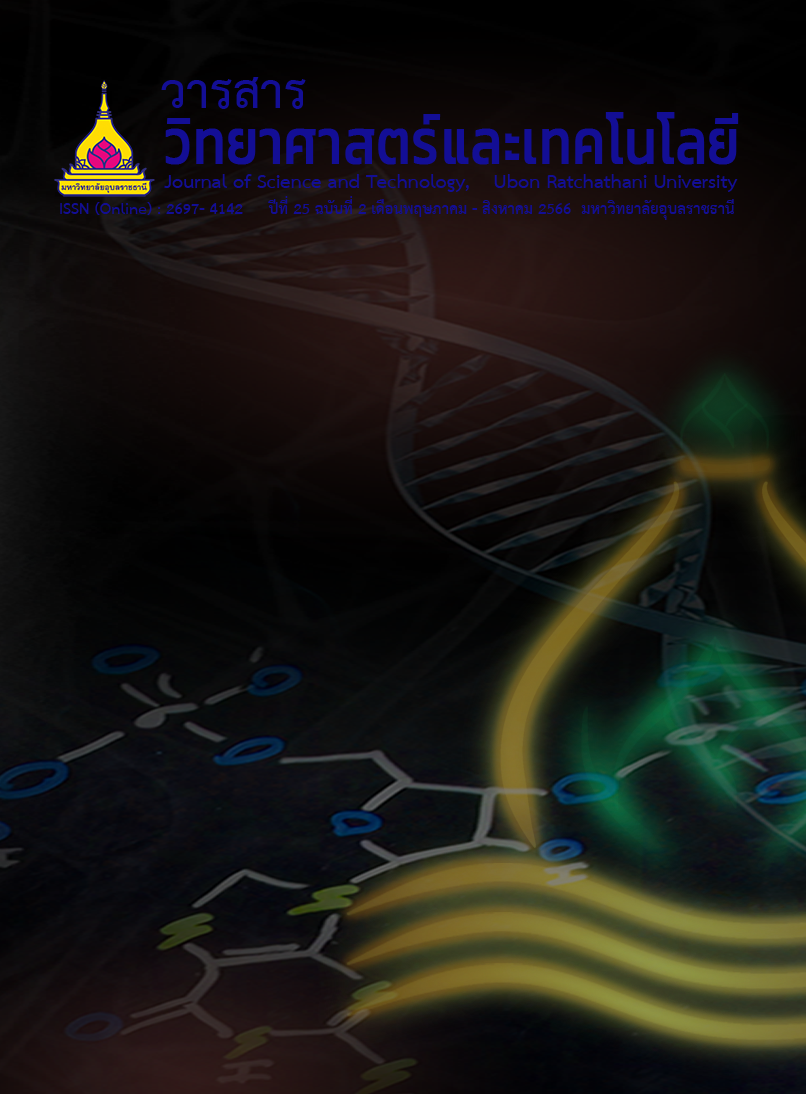สารออกฤทธิ์ทางชีวภาพและฤทธิ์ต้านอนุมูลอิสระของข้าวเหนียวพันธุ์ กข 6 ระยะเม่า
Main Article Content
บทคัดย่อ
ข้าวระยะเม่าเป็นข้าวที่ยังไม่แก่เต็มที่ แต่อุดมไปด้วยสารออกฤทธิ์ทางชีวภาพ งานวิจัยนี้มีวัตถุประสงค์เพื่อศึกษาปริมาณสารออกฤทธิ์ทางชีวภาพ และฤทธิ์ต้านอนุมูลอิสระของข้าวเหนียวพันธุ์ กข 6 ระยะเม่า การศึกษาปริมาณสารออกฤทธิ์ทางชีวภาพใช้วิธี high performance liquid chromatography (HPLC) และ ultra performance liquid chromatography (UPLC) ส่วนการศึกษาฤทธิ์ต้านอนุมูลอิสระใช้วิธี 2,2′-azinobis (3-ethylbenzothiazoline 6-sulfonate) assay (ABTS assay), ferric reducing antioxidant power assay (FRAP assay) และ thiobarbituric acid reactive substances assay (TBARS assay) จากการศึกษาด้วยวิธี HPLC พบว่าข้าวเหนียวพันธุ์ กข 6 ระยะเม่า มี ไนอะซิน ไพริดอกซีน ไทอะมีน แอลฟาโทโคฟีรอล และแกมมาออไรซานอล เท่ากับ 14.33±0.02, 36.18±0.14, 11.47±0.02, 274.27±4.39 และ 259.59±4.41 มิลลิกรัมต่อ 100 กรัมน้ำหนักแห้ง ตามลำดับ จากการใช้วิธี UPLC ศึกษาปริมาณสารประกอบฟีนอลิก พบว่าข้าวเหนียวพันธุ์ กข 6 ระยะเม่ามีสารประกอบฟีนอลิกหลายชนิด โดยกรดซิแนปิกเป็นสารประกอบฟีนอลิกที่พบมากที่สุด เท่ากับ 122.81±5.20 ไมโครกรัมต่อกรัมน้ำหนักแห้ง จากการศึกษาฤทธิ์ต้านอนุมูลอิสระของข้าวเหนียวพันธุ์ กข 6 ระยะเม่าด้วยวิธี ABTS assay, FRAP assay และ TBARS assay พบว่ามีค่าเท่ากับ ร้อยละ 92.18±0.08, ร้อยละ 71.25±1.20 และ ร้อยละ 51.07±1.21 ตามลำดับ งานวิจัยนี้ชี้ให้เห็นว่าข้าวเหนียวพันธุ์ กข 6 ระยะเม่าประกอบด้วยสารออกฤทธิ์ทางชีวภาพหลายชนิด และมีฤทธิ์ต้านอนุมูลอิสระ
Article Details

อนุญาตภายใต้เงื่อนไข Creative Commons Attribution-NonCommercial-NoDerivatives 4.0 International License.
บทความที่ได้รับการตีพิมพ์เป็นลิขสิทธิ์ของ วารสารวิทยาศาสตร์และเทคโนโลยี มหาวิทยาลัยอุบลราชธานี
ข้อความที่ปรากฏในบทความแต่ละเรื่องในวารสารวิชาการเล่มนี้เป็นความคิดเห็นส่วนตัวของผู้เขียนแต่ละท่านไม่เกี่ยวข้องกับมหาวิทยาลัยอุบลราชธานี และคณาจารย์ท่านอื่นๆในมหาวิทยาลัยฯ แต่อย่างใด ความรับผิดชอบองค์ประกอบทั้งหมดของบทความแต่ละเรื่องเป็นของผู้เขียนแต่ละท่าน หากมีความผิดพลาดใดๆ ผู้เขียนแต่ละท่านจะรับผิดชอบบทความของตนเองแต่ผู้เดียว
เอกสารอ้างอิง
Bangkokbiznews, 2022. Thai Rice Exports in 2021, Losing to India and Vietnam. https://www.bangkokbiznews.com/business/985817. Accessed 15 July 2022.
Jansamood, C. and et al. 2017. Soil properties for glutinous rice RD 6 between Khao-wong and Namon district Kalasin province. Chalermkanchana Academic Journal. 4(2): 15-20. (in Thai)
Punnongwa, W. and et al. 2022. Bioactive compounds and antioxidant activities of Khao Khaow Dawk Mali 105. Agriculture and Technology Journal. 3(1): 89-102. (in Thai)
Liu, R. and et al. 2021. Antioxidant interaction of α-tocopherol, γ-oryzanol and phytosterol in rice bran oil. Food Chemistry. 343: 128431.
Kim, S.K. and et al. 2019. Use of rice bran for preparation of GABA (γ-aminobutyric acid)-rich sourdough. Food Science and Technology Research. 25(3): 399-404.
Morarach, A. and Hemathulin, S. 2022. Development of healthy fermented mushroom products with colored rice. Journal of Science and Technology, Ubon Ratchathani University. 24(10): 40-53. (in Thai)
Saji, N. and et al. 2019. Rice bran derived bioactive compounds modulate risk factors of cardiovascular disease and type 2 diabetes mellitus: An updated review. Nutrients. 11(11): 2736.
Yu, Y. and et al. 2019. The anti-cancer activity and potential clinical application of rice bran extracts and fermentation products. RSC Advances. 9, 18060-18069.
Tan, X.W. and et al. 2020. Antioxidative attributes of rice bran extracts in ameliorative effects of atherosclerosis-associated risk factors. Heliyon. 6(12): e05743.
Teravecharoenchai, J., Chalermchaiwat, P. and Thuwapanichayanan, R. 2021. Principal component analysis application on nutritional, bioactive compound and antioxidant activities of pigmented dough grain. Chiang Mai University Journal of Natural Sciences. 20(2): e2021036.
Association Official Analytical Chemists (AOAC). 2000. Official Method of Analysis of AOAC International. 17th edition. Gaithersburg, MD: AOAC International.
Butsat, S., Weerapreeyakul, N. and Siriamornpun, S. 2009. Changes in phenolic acids and antioxidant activity in Thai Rice husk at five growth stages during grain development. Journal of Agricultural and Food Chemistry. 57(11): 4566–4571.
Shao, Y. and et al. 2014. Phenolic acids, anthocyanins, and antioxidant capacity in rice (Oryza sativa L.) grains at four stages of development after flowering. Food Chemistry. 145: 90-96.
Galli, F. and et al. 2022. Vitamin E (alpha-tocopherol) metabolism and nutrition in chronic kidney disease. Antioxidants. 11(5): 989.
Minatel, I.O. and et al. 2016. Antioxidant activity of γ-oryzanol: A complex network of interactions. International Journal of Molecular Sciences. 17(8): 1107.
Pang, Y. and et al. 2018. Bound phenolic compounds and antioxidant properties of whole grain and bran of white, red and black rice. Food Chemistry. 240: 212-221.
Punnongwa, W. and et al. 2022. Application of mild-subcritical alkaline water extraction: optimum condition for phenolic antioxidant extracted from coldpressed defatted KDML 105 rice bran and its phenolic profile. Food Research. 6(1): 120-131.


